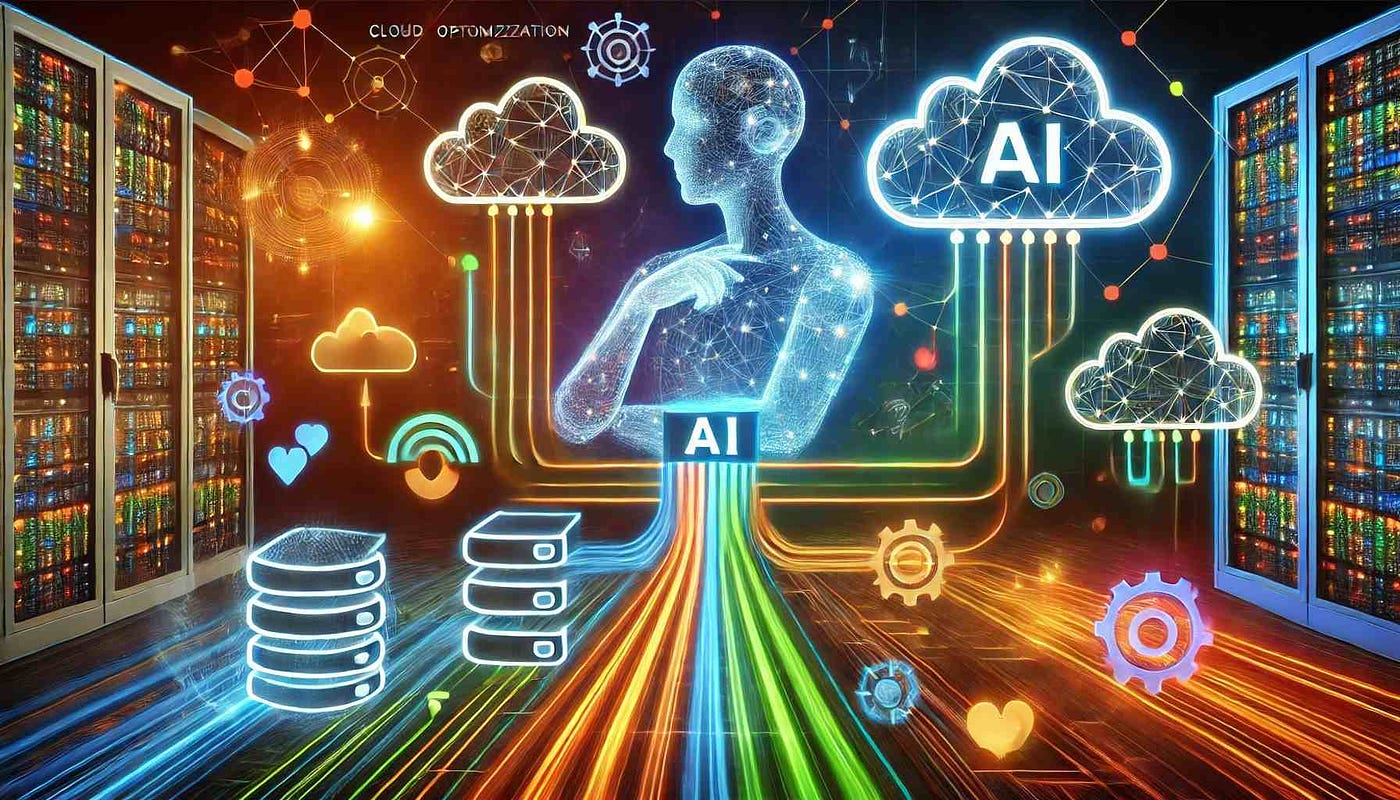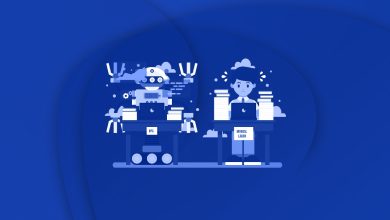AI in Cloud Optimization

What is AI in Cloud Optimization?
AI in cloud optimization involves using artificial intelligence to improve cloud performance, resource management, and cost efficiency. With cloud adoption growing, companies are seeking ways to reduce costs and maximize efficiency. AI provides a powerful solution by automating resource allocation, optimizing workloads, and predicting future needs.
AI algorithms can analyze vast amounts of data, identifying patterns and trends. This insight helps businesses manage cloud resources better, avoiding unnecessary spending and improving performance. By leveraging AI, companies can gain more value from their cloud infrastructure and make data-driven decisions.
How AI Enhances Cloud Optimization
AI-driven cloud optimization helps organizations achieve higher efficiency and cost savings. Here’s how AI makes a difference:
1. Automated Resource Allocation
AI can automate the allocation of cloud resources, ensuring that companies use only what they need. Traditional cloud environments require manual scaling, which can be inefficient and costly. AI models can monitor resource usage in real time and adjust resources automatically based on demand.
This automation prevents over-provisioning, reducing wasted resources and costs. AI-powered allocation ensures that businesses have the right amount of capacity without paying for idle resources. For instance, AI can scale down resources during low traffic periods, saving costs, and ramp them up during peak times.
2. Cost Management and Reduction
Cost control is a priority for organizations using cloud services. AI helps manage and reduce costs by analyzing usage patterns and identifying areas of potential savings. For example, AI can detect underutilized resources or unused instances and suggest ways to optimize them.
AI also identifies the best pricing models for specific workloads, whether it’s on-demand, reserved, or spot instances. By recommending the most cost-effective options, AI helps businesses optimize spending and avoid overpaying for cloud services.
3. Predictive Analytics for Demand Forecasting
AI’s predictive analytics capabilities allow businesses to forecast demand accurately. AI algorithms analyze historical data to predict future workloads and resource needs. With this information, companies can prepare for peak periods or plan for upcoming projects.
By forecasting demand, AI helps companies avoid resource shortages or unexpected costs. This proactive approach ensures that businesses can scale resources in advance, maintaining performance without incurring sudden expenses.

Benefits of Using AI for Cloud Optimization
Implementing AI in cloud optimization offers several key benefits that improve performance, reduce costs, and enhance scalability.
1. Improved Efficiency
AI streamlines cloud operations by automating routine tasks. This automation frees up IT teams, allowing them to focus on strategic goals instead of manual resource management. AI can perform tasks like scaling, monitoring, and security checks faster than humans, ensuring higher efficiency.
By improving efficiency, AI reduces operational costs and enables teams to work on innovation rather than maintenance. This approach enhances overall productivity and ensures that cloud resources are managed more effectively.
2. Enhanced Scalability
Scalability is essential in cloud environments. AI supports dynamic scaling, allowing resources to adjust based on demand. Whether a company experiences a sudden spike in traffic or needs additional capacity for a new project, AI can handle scaling in real-time.
This scalability makes it easier for businesses to handle growth and unexpected demands. AI ensures that companies can meet demand without compromising performance, helping them remain agile and responsive.
3. Better Security and Compliance
AI plays a significant role in cloud security. AI algorithms can detect unusual activity or potential security threats in real-time. By analyzing behavior patterns, AI can alert teams to potential issues, such as unauthorized access or malware attacks, enabling quicker responses.
For compliance, AI can monitor data handling and storage to ensure it aligns with industry regulations. This helps companies avoid compliance violations, which can result in legal or financial penalties. AI-driven security features make cloud environments safer and more compliant.
Common AI Applications in Cloud Optimization
AI is used across various areas in cloud optimization, from managing workloads to enhancing data storage. Here are some key applications:
1. Workload Optimization
AI optimizes workloads by distributing tasks efficiently across cloud resources. By analyzing each task’s requirements, AI determines the best resources for execution, balancing workload distribution to prevent resource strain.
This workload optimization reduces latency and improves application performance. For instance, AI can allocate high-demand tasks to faster servers and less critical tasks to lower-capacity resources. This approach ensures that all applications run smoothly without overwhelming any part of the system.
2. Storage Optimization
Storage costs are a significant part of cloud expenses. AI helps optimize storage by analyzing usage patterns and suggesting improvements. For instance, AI can identify infrequently accessed data and move it to lower-cost storage tiers, saving costs without affecting accessibility.
Additionally, AI helps manage data redundancy. By identifying duplicate data, AI allows businesses to reduce storage needs and costs. This optimization maximizes storage efficiency and prevents unnecessary spending.
3. Performance Monitoring and Tuning
AI provides continuous monitoring of cloud resources, ensuring optimal performance. AI algorithms track key metrics, such as response times, CPU usage, and network latency, to detect performance issues. If any metric falls outside the desired range, AI can adjust resources or suggest tuning options.
With AI, performance monitoring is proactive rather than reactive. Instead of waiting for issues to arise, AI identifies and resolves potential problems before they impact users. This proactive monitoring improves application reliability and user experience.

4. Disaster Recovery and Backup
AI enhances disaster recovery by automating data backups and optimizing recovery plans. In case of a failure, AI can identify the quickest way to restore data and resume operations. By analyzing potential risks, AI helps companies create more resilient backup strategies.
AI also reduces downtime by automating recovery processes. Instead of relying on manual intervention, AI systems can restore data and applications quickly. This approach minimizes business disruption and ensures faster recovery from unexpected events.
Challenges of AI in Cloud Optimization
While AI offers many benefits, implementing it in cloud optimization comes with challenges.
1. High Implementation Costs
AI technology can be costly to implement initially. Setting up AI infrastructure, acquiring software, and training staff requires a significant investment. Small to medium-sized businesses may find these costs challenging, especially when balancing budgets.
2. Data Privacy Concerns
AI processes large amounts of data, some of which may be sensitive. Ensuring data privacy and compliance is crucial, as any breach can harm the business. Organizations must take steps to secure data and comply with privacy regulations like GDPR or HIPAA.
3. Skill Shortages
Managing AI-based cloud systems requires specialized skills, which can be scarce. Many organizations face a shortage of skilled AI professionals. This shortage can delay AI projects and impact cloud optimization efforts.
To overcome this, companies may need to invest in training programs or consider hiring external experts to manage AI-driven cloud systems.
Future of AI in Cloud Optimization
AI in cloud optimization is expected to grow as technology advances. Innovations in AI, such as machine learning and edge computing, will make cloud environments even more efficient and responsive.
Edge computing, for instance, brings processing closer to the data source, reducing latency and enhancing performance. Combined with AI, edge computing can optimize real-time applications like IoT and video streaming.
AI’s ability to adapt and learn will also improve. Future AI models will become more precise, handling complex tasks without constant human input. These advancements will make AI-driven cloud optimization more accessible and beneficial for businesses of all sizes.
Conclusion: Embracing AI for Optimal Cloud Performance
AI in cloud optimization offers businesses a way to improve efficiency, reduce costs, and enhance security. From automated scaling to predictive analytics, AI empowers organizations to manage cloud resources intelligently. By implementing AI-driven solutions, companies can optimize cloud performance, ensuring they get the best value from their cloud investment.
While challenges exist, the benefits of AI in cloud optimization are substantial. As AI technology advances, it will continue to shape the future of cloud computing. Companies that embrace AI for cloud optimization today will be better positioned to lead in an increasingly digital world.




